Maine has a lot to offer to any bird enthusiast or just any traveler. The state is popular for hosting hundreds of Atlantic puffins nesting on its four islands. However, it’s not only puffins you will see in Maine; the state also provides habitat to around 460 species of birds, but 290 of them are regular guests. There are tons of great birding hotspots to explore in Maine.
Hawks are also commonly sighted in Maine. About ten species of hawk reside in various habitats within the state. Below, we will look at the 8 types of hawks found in Maine. You’re most likely to spot more than one of these raptors, from some of the most beautiful rocky shorelines and mountain peaks to picturesque lighthouses and fragrant conifer forests.
Let’s take a look!
1. Red-shouldered Hawk
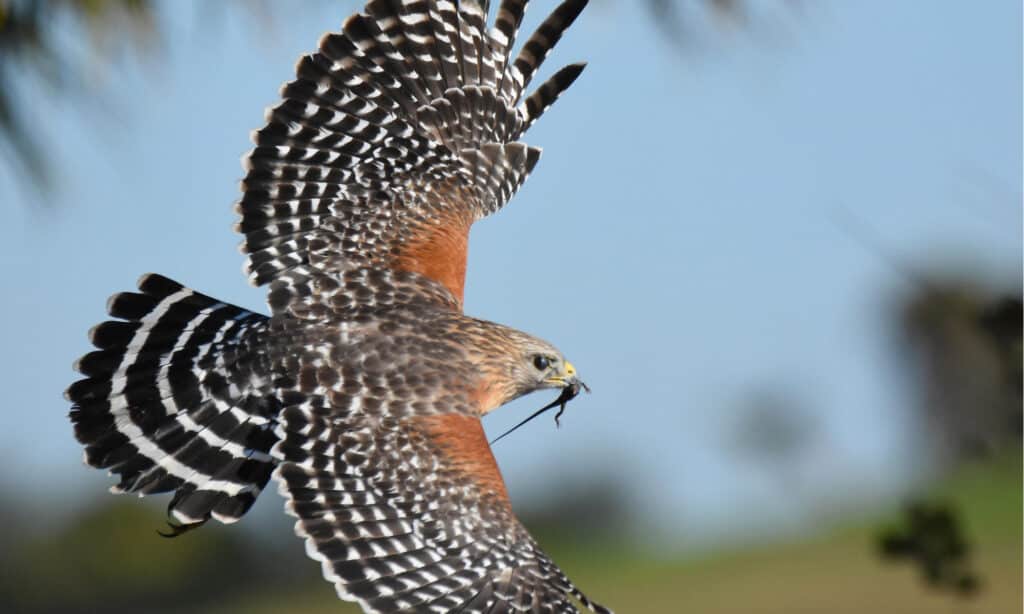
Red-shouldered hawks are commonly sighted in Maine’s woodlands, swamps, and forests.
©MTKhaled mahmud/Shutterstock.com
| Red-shouldered Hawk | |
|---|---|
| Scientific name | Buteo lineatus |
| Weight | 1-1.7 lbs (486-774g) |
| Height | 15-24 in (38-61 cm) |
| Wingspan | 35-50 in (90-127 cm) |
Red-shouldered hawks are best known as the hawks of woodlands. They are normally heard before being seen due to their distinct vocals. They are medium to large and have rich red barring on their underparts and chests. They have broad, rounded wings with white-and-black checkered patterns.
Red-shouldered hawks are commonly sighted in Maine’s woodlands, swamps, and forests, especially in the summer and spring months of their breeding seasons. They build their nests in deciduous trees, sometimes conifers, located at the base of the branches. Females lay between 3 and 4 eggs that hatch in roughly 33 days.
Their diet consists of small birds, large insects, mice, snakes, crayfish, frogs, and occasionally carrion. They hunt by flying low in open areas or watching for prey from a raised perch.
2. Broad-winged Hawk
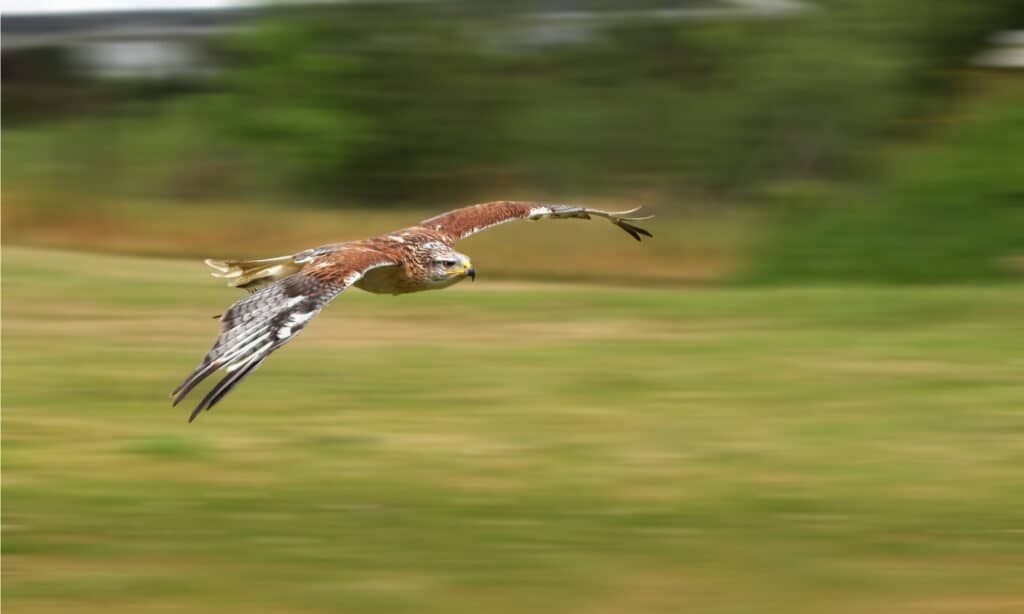
Broad-winged hawks are well-known for their large, pointed wings.
©pr2is/Shutterstock.com
| Broad-winged Hawk | |
|---|---|
| Scientific name | Buteo platypterus |
| Weight | 9-20 oz |
| Height | 13-17 in |
| Wingspan | 32-39 in |
Broad-winged hawks are well-known for their large, pointed wings. They are common in Maine in spring and summer. The best time to watch for them is during their migration in the fall. They have unique markings on their underparts, black-and-white banded tails, and reddish-brown heads.
Broad-winged hawks inhabit groves and woods. They nest in either mixed coniferous-deciduous forests or pure deciduous forests. Females lay 2-3 eggs that hatch at around 28-31 days.
Broad-winged hawks mainly feed on squirrels, voles, mice, small birds, lizards, snakes, frogs, young turtles, large insects, and many other small mammals. They hunt from a perch or occasionally fly through woods in search of a meal.
3. Cooper’s Hawk

Cooper’s hawks mainly feed on medium-sized birds, mice, ground squirrels, chipmunks, insects, and reptiles.
©Richard G Smith/Shutterstock.com
| Cooper’s Hawk | |
|---|---|
| Scientific name | Accipiter cooperii |
| Weight | 8-15 oz (220-410 g) |
| Height | 14-20 in (35-50 cm) |
| Wingspan | 24-39 in (62-99 cm) |
Cooper’s hawks are well-known as the medium-sized raptors of the woodlands. They are often compared to the size of crows. They have long, narrow tails and broad, rounded wings. They are blue-gray on top with a red-orange barring on their underparts.
These hawks are generally found along river groves, open woodlands, forests, and wood edges. They are sighted in Maine between March and July during their breeding seasons. They build their nests in dense woodlands where females lay 3-5 pale bluish-white eggs.
Cooper’s hawks mainly feed on medium-sized birds, mice, ground squirrels, chipmunks, insects, and reptiles. They hunt either from their perches or fly low over the ground, searching for prey.
4. Northern Harrier

Northern harriers can be seen in fields, prairies, and marshes.
©Harry Collins Photography/Shutterstock.com
| Northern Harrier | |
|---|---|
| Scientific name | Circus hudsonius |
| Weight | 11-27 oz (300-750 g) |
| Height | 21-25 in (53-64cm) |
| Wingspan | 41-46 in (103-117 cm) |
Northern harriers are very distinctive medium-sized birds of prey with long wings and long tails. Male hawks are gray on top with very dark feathers near their wings. The immature hawks and females have brown streaked feathers. They are often sighted in Maine, especially in the late autumn months.
Northern harriers are found in many types of terrain. They can be seen in fields, prairies, and marshes. They often nest in marshes, though they sometimes prefer nesting in open fields. Females lay between 4 and 6 eggs that hatch in about 30-32 days.
Their diet mainly consists of small birds, rats, voles, lizards, frogs, and large insects, among other small mammals. They hunt by hovering over dense cover or open fields, scanning the ground and trees in an attempt to locate some prey.
5. Northern Goshawk
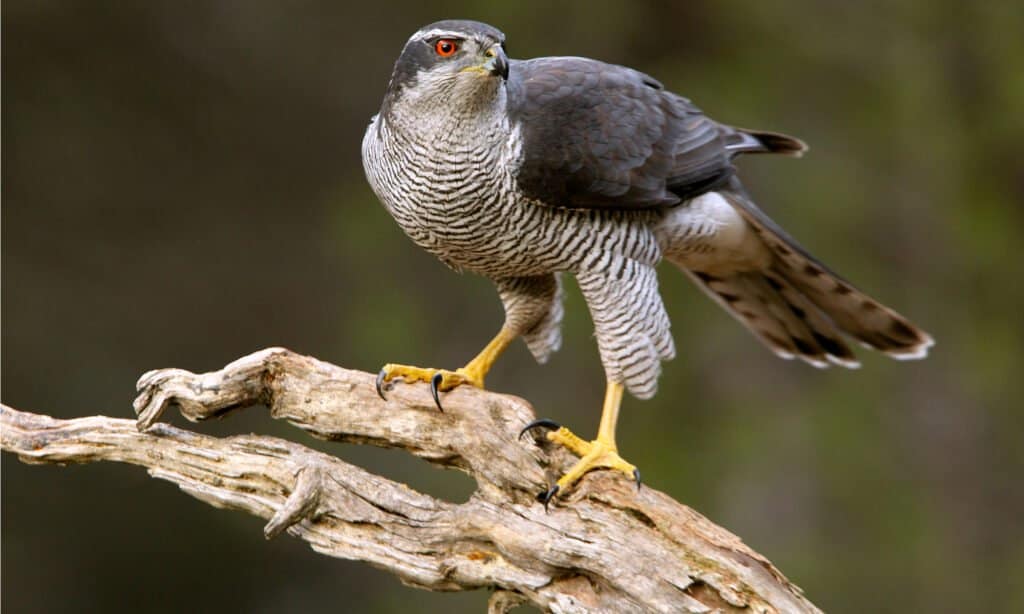
Northern goshawks are normally found in dense coniferous and mixed forests.
©Jesus Giraldo Gutierrez/Shutterstock.com
| Northern Goshawk | |
|---|---|
| Scientific name | Accipiter gentilis |
| Weight | 1.4-4.8 lbs |
| Height | 18-27 in (46-69 cm) |
| Wingspan | 40-46 in (103-117 cm) |
Northern goshawks are medium-sized raptors commonly found in Maine. They are often called Maine’s fiercest birds of prey because they are very defensive when defending their territory. They are pale-grayish above with a white-streaked underside. Immatures are streaked brown.
Northern goshawks are solitary raptors restricted to wooded areas. They are normally found in dense coniferous and mixed forests. They nest in pure stands of coniferous trees. Females lay 2-4 eggs that hatch in 32-38 days.
Their diet consists of snowshoe hares, rabbits, squirrels, medium-sized birds, snakes, insects, and rodents. They hunt inside forests or along the edges. They move from one perch to another in search of prey. They fly in very short, powerful bursts, often crashing and twisting between branches as they go after their prey.
6. Sharp-shinned Hawk
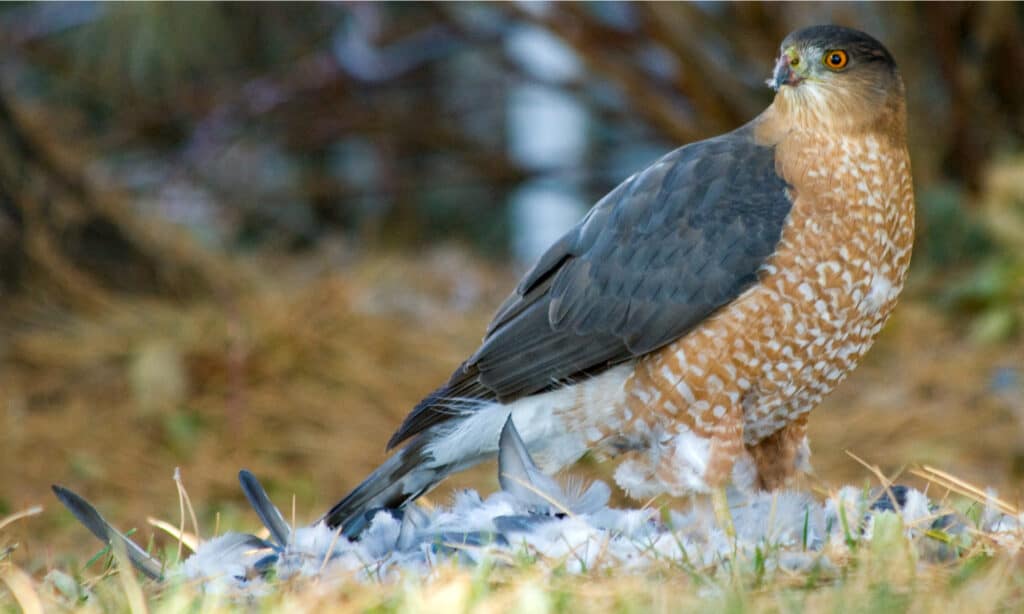
Sharp-shinned hawks primarily feed on small birds, rodents, squirrels, large insects, frogs, lizards, and snakes.
©Wyatt W/Shutterstock.com
| Sharp-shinned Hawk | |
|---|---|
| Scientific name | Accipiter striatus |
| Weight | 2.9-7.7 oz (82-219 g) |
| Height | 9.1-15 in (23-37 cm) |
| Wingspan | 17-27 in (42-68 cm) |
Sharp-shinned hawks are the smallest species of hawk found in Maine during breeding seasons from March to June. They are gray on top with red-orange underparts. Their wings are short and rounded.
They are usually sighted along coastlines and mountain ridges during their migrations. They prefer nesting in forests and woodlands during their breeding season. Females lay between 4-5 eggs, which take around 30-35 days to hatch.
Sharp-shinned hawks primarily feed on small birds, rodents, squirrels, large insects, frogs, lizards, and snakes. They hunt by watching for prey movement from a raised perch or mayfly rapidly among trees, taking unsuspecting prey by surprise.
7. Red-tailed Hawk
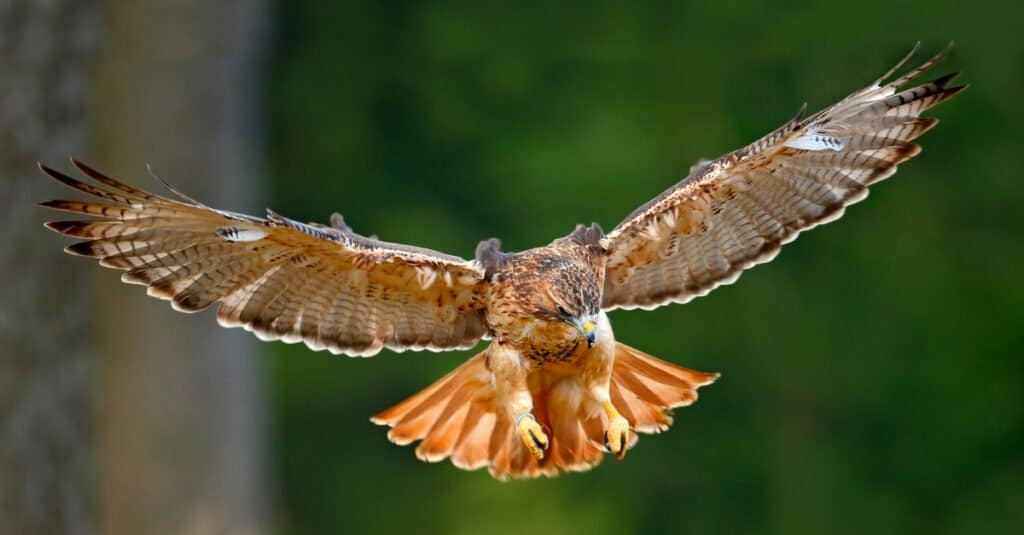
Red-tailed hawks mainly feed on small birds, snakes, voles, rabbits, ground squirrels, toads, frogs, and large insects.
©Ondrej Prosicky/Shutterstock.com
| Red-tailed Hawk | |
|---|---|
| Scientific name | Buteo jamaicensis |
| Weight | 1.5-3.5 lbs |
| Height | 18-26 in (45-65 cm) |
| Wingspan | 43-56 in (110-141 cm) |
Red-tailed hawks are the most commonly sighted hawks throughout Maine. They are the largest hawks in the state. They have striking red tails that make them different from other raptors.
They are often spotted along the roadsides, in the woodlands, mountains, prairie groves, and plains. They nest on tall trees, cliff ledges, and artificial structures. Females lay between 2-3 eggs that hatch in about 28-35 days.
Red-tailed hawks mainly feed on small birds, snakes, voles, rabbits, ground squirrels, toads, frogs, and large insects. They hunt by flying over fields, watching for prey movement below. They also watch for prey from perches.
8. Rough-legged Hawk
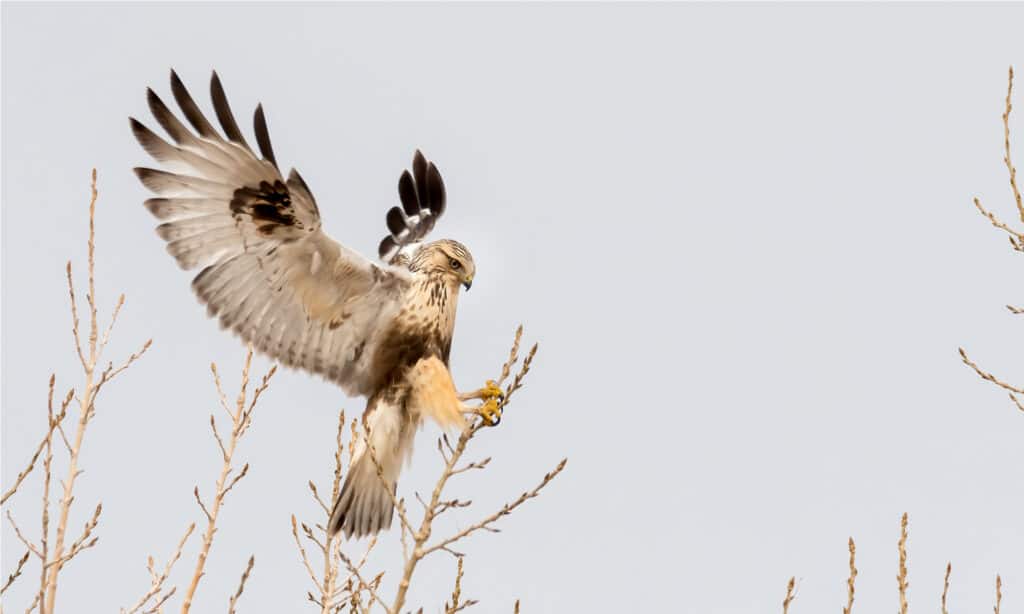
Rough-legged hawks live on arctic coasts and tundra escarpments.
©Eivor Kuchta/Shutterstock.com
| Rough-legged Hawk | |
|---|---|
| Scientific name | Buteo lagopus |
| Weight | 1.32-3.66 lbs |
| Height | 18–24 in (46–60 cm) |
| Wingspan | 52-54 in (132-138 cm) |
Best known for their feathered legs, rough-legged hawks are generally found in Maine all year. They are medium-sized birds of prey with a wide range of color patterns. They have dark bands on their white underparts. Their wings are long but notably thin.
These hawks are tied to cold climates. They live on arctic coasts and tundra escarpments, though they like spending winter in open fields, coastal prairies, marshes, dunes, and grasslands. They nest on slopes or high cliffs. Females lay between 3 and 5 eggs. The incubation period lasts for about 31 days.
Rough-legged hawks feed on mostly rodents. Lemmings and voles are their favorites. They also eat small birds, ground squirrels, and other small mammals. They hunt by watching for prey from a perch or by hovering over fields to catch sight of prey on the ground.
The photo featured at the top of this post is © Milan Zygmunt/Shutterstock.com
Thank you for reading! Have some feedback for us? Contact the AZ Animals editorial team.






